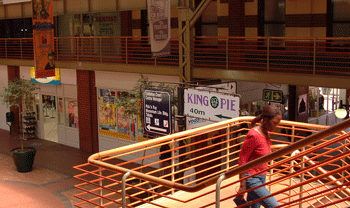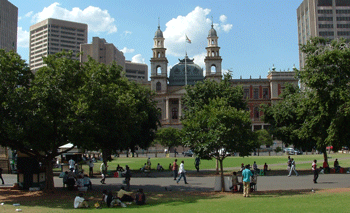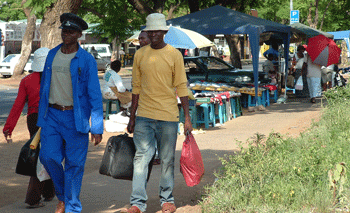Tales of a 21st Century Gypsy
January 14, 2004 Pretoria, South Africa
I had an afternoon off from meetings, and spent some time walking – shuffling, more like – around downtown Pretoria. I don’t quite know what to make of it. It has no charm, and not much character. It looks new, square, and uninteresting. But you know, it’s probably like those New Jersey towns – if I worked there, and knew the nooks and crannies, and what distinguished one little pie shop or another little grocery shop, or which fruit-seller had the good mangos, then perhaps I would see its character. The buildings are chunky blockish things, lined with shops on the street level. That’s a good thing, of course – too many Washington DC buildings have nothing but lobbies at street level. There are a lot of furniture stores, for some reason. Lots of snack shops that sell ready-made sandwiches and drinks and savory pies – chicken or beef or spinach and cheese. There’s a chain called Butterfield Bread, that sells loaves and pastries and snacks. I went into one and bought something that I thought was cinnamon, but now that I have it in my hotel room I realized it isn’t. I don’t know what it is, though, I haven’t tasted it.


 |
It was horribly hot outside, so I went into a lot of the shopping arcades that occupy the lower floors of many of the buildings. They are quite ordinary, filled with conventional places – cheap clothing stores, snack shops, fast food places, stalls selling cheap beads and jewelry, dry cleaners, shoe stores, and endless cellphone stores. In the one with the best air conditioning, up on the third floor, I came across a little Italian restaurant so I stopped for lunch. Not very good, but the owner was amusing and chatty and the place was quiet, so it a good reprieve from the heat and the sun.
I did come across one square that felt quite different from the rest. It’s called Church Square, the middle is a park with lawns and trees. Dozens of people lounged in the meager shade of each tree - office workers, well-dressed folks – but no on in the sun. Along the paths telephone vendors sat with their phones, where you could make a call for half a rand per unit. A few stalls sold snacks. At the edges of the square sweeping staircases led down from the street, burbling fountains nestled in their curves. Around the square the buildings were unlike anything else I’d seen, fancy Dutch architecture with frills and curlicues. One, inscribed “Nederlandse Bank,” is now the tourist office, where I stopped to get info about buses. The walls of their office were painted green, decorated with a painted frieze of white flowers on vines. In one spot a piece of glass covered the original decoration, a similar frieze now faded to almost invisible. Across from the tourist office/bank a coffee shop occupied the street level of an old white house that might have been in Delft, not Pretoria. Double-decker buses waited on the edge of the square. Initially I took them for tourist buses, and thought this must be the one charming spot in Pretoria that tourists visited. But they weren’t, they were public buses waiting at the start of their runs, and a little stone house at the edge of the park housed an office where friendly conductors provided bus information. I didn’t see any tourists at all - I think Pretoria doesn’t have any.
I found out where my bus would depart from, but strayed a few blocks north to a spot that was very different from Church Square or the rest
of the drab central business district. Bloed Street was lined with street vendors and vans picking up commuters for all destinations. Van der Walt Street Street, around the corner, was positively chaotic, the sidewalks lined with people selling shirts, underwear, sun hats, sunglasses, cellphones, fruits and vegetables, backpacks, and other everyday items. Between the rows of vendors, crowds of people streamed from the offices a few blocks away towards the minivans, carrying bags of groceries or merchandise picked up on the way home from work. When I asked Piet at the Parks Department this morning whether I would be able to take a bus back to the Holiday Inn he said he had no idea, he hadn’t taken a bus in ten years, but he supposed so. Well, the rest of Pretoria takes buses all the time, from the looks of it, the black Pretoria that doesn’t drive to work every day in a nice car.
Not that it would be so different in much of the US, so I shouldn’t be snide.
I actually am working here, not just wandering around cities in the heat. Work involves reading a few documents, but mostly talking to people in the parks departments of the three countries that are part of the Great Limpopo Transfrontier Park, to hear their thoughts about how the entry fees for the park should be designed. It’s interesting – though I do think that the fact that I consider this an interesting question may be evidence of my utter nerdiness. Okay, so here’s the brief explanation. South Africa, Mozambique, and Zimbabwe have signed a treaty agreeing to create a transfrontier park by combining South Africa’s Kruger National Park, Mozambique’s Limpopo National Park (which doesn’t exactly exist yet), and Zimbabwe’s Gonorezhou National Park. Transfrontier parks are the latest brainchild of the wildlife conservation community, based on the fairly straightforward idea that it makes sense to manage wildlife at the ecosystem scale rather than according to national boundaries. So the question is, do they charge one entry fee for the whole transfrontier park and then find some equitable way to split the revenue among three countries? Or does each country set its own fee for its own portion of the park, and you pay separately for each part you enter? Or other permutations that are a mix of these scenarios. Well, I won’t go into the technical details (if you are interested, email me), but my task is to sort out many different proposals, scope out what people in each country consider fair, and then make recommendations to the trilateral Joint Management Board that must decide what to do. The amusing thing is that they all make pompous speeches about the need for the system chosen to be “fair,” but then they follow up with equally pompous pronouncements about why the strategy that gives their country the most money is obviously the only fair one. So my task is to find a way to point that out without offending anyone, and then try to gently push them into evaluating options from a perspective beyond pure self-interest.
I’ve found the right way to parody their self-interest and perhaps get them to see some of their bias:
Mozambique: Kruger National Park has too many elephants. SANParks needs the space in Limpopo to provide elephant habitat, or their own resources will be destroyed by those animals. They should pay us for providing homes for their elephants, that’s only fair!
South Africa: The transfrontier park is providing Mozambique with a splendid opportunity to tap into the huge South African tourist market, the million people a year who come to visit Kruger. We’re providing them something great there, but it’s only fair that they pay us for our elephants. Those animals are a wonderful opportunity to invest in a superior tourist attraction, and we should be compensated for them!
It’s fun.
Continue to the next entry.
Return home.